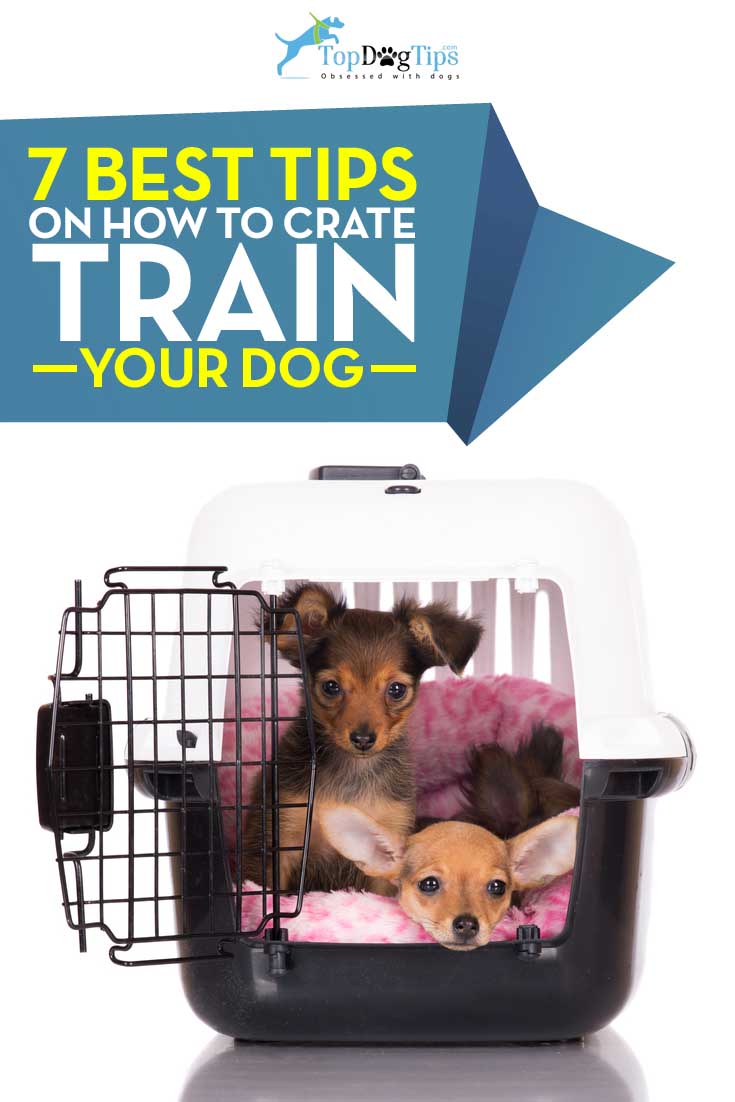
 Most professionals in the pet industry agree that crate training is an effective and humane method to use with any puppy or adult dog. Like most types of training, it's easiest to work with a puppy, but it's not impossible to crate train an adult dog. With patience, consistency and these tips for crate training your dog, you'll be on your way to success in no time!
Most professionals in the pet industry agree that crate training is an effective and humane method to use with any puppy or adult dog. Like most types of training, it's easiest to work with a puppy, but it's not impossible to crate train an adult dog. With patience, consistency and these tips for crate training your dog, you'll be on your way to success in no time!
The idea for crating a dog is built on the concept that dogs are denning animals. Wild dogs dig holes or find small areas to curl up in and sleep. This gives them protection and security and also provides a safe place to birth pups and raise a family.
What we need to remember is that wild dogs do not spend their days cooped up in their den. If used properly, your Fido will learn to love his crate and think of it as his den – a safe place to rest and relax. If you fail to follow these tips for crate training your dog, he may end up being scared of his crate and not wanting to ever spend any time inside it.
RELATED: 10 Lessons on Effectively Crate Training Adult Dog
7 Tips for Crate Training Your Dog
Crate training is the fastest way to house train your dog. By nature, dogs will not go to the bathroom where they sleep. If you buy an appropriately sized crate it will help your dog realize that he needs to hold it until he goes outside.
And, of course, crate training allows you to leave your pet at home unsupervised without having to worry about him chewing up your belongings.
1. APDT.com
You also need to understand when it isn't appropriate to use a dog crate. This resource from the Association of Professional Dog Trainers explains that there is most definitely a wrong way to use a crate:
When should you not use a crate
- If you are trying to punish your dog – the dog will learn to avoid the crate and refuse to go inside, or he will become extremely agitated in an attempt to be let out of the crate.
- If you are looking for a long-term place to “store” your dog for hours and hours on end. Ideally, an adult dog should not be left in a crate for more than four to five hours at a time. For puppies, you cannot leave them in the crate longer than their physical bladder capacity, which depending on their age and breed can be no more than an hour or so.
If you need to leave your puppy alone for long hours, it's best to have a pet sitter or dog walker come to care for him in the middle of the day. You could also ask a family member or neighbor to check on your Fido. This is one of my favorite tips for crate training your dog, as it's the most important for your dog's comfort.
2. Animal Humane Society
If none of these options are feasible for you, the Animal Humane Society has some advice:
- Behaviorist and veterinarian Ian Dunbar recommends a long-term confinement area: this can be a small bathroom, kitchen or an ex-pen (a freestanding circular “fence” for puppies and small dogs), containing the pup’s crate (with door removed), water, toys and potty area. The potty area can consist of newspaper, pee pads or even a square of sod in a cat litterbox. This allows puppy to sleep in her crate but potty on an approved surface. This containment method can also be used if you must leave your puppy for longer than she can hold her bowels and bladder: this usually means your puppy’s age in months plus one. In other words, a 3-month-old puppy can generally be left for a maximum of four hours.
Choosing a crate for your dog is a process in itself. You'll have to do a lot of research to ensure you pick the right one. For more information, check out our article on picking out the right dog crate. The Ohio State University College of Veterinary Medicine has some great tips for choosing the right crate too.
3. Indoor Pet
This article on their website explains how to choose the right crate for your pet and also some great tips for crate training your dog. First thing is first, you need to make your dog's kennel a happy place to be.
- Put the crate in an area of the house where your family spends a lot of time…Toss delicious treats and toys inside and allow the puppy to go into the crate on her own. Let her walk in and out with the door open several times with treats before you leave her inside with the door closed. You can then start feeding her meals and food-stuffed toys inside her crate and eventually close the door when she is eating comfortably.
After you introduce your dog to the crate, he'll need a couple of days to properly adjust to spending time in there. Start with small increments of time and work your way up. The Humane Society of the United States has published a wonderful article with tips for crate training your dog from start to finish.
4. Humane Society
They explain how to gradually get your dog accustomed to staying in his crate in a very simple way. This is one of the most important tips for crate training your dog. I love how easy this article is to follow and understand.
- Sit quietly near the crate for five to ten minutes, and then go into another room for a few minutes. Return, sit quietly again for a short time, and then let him out of the crate.
- Repeat this process several times a day, gradually increasing the length of time you leave him in the crate and the length of time you're out of his sight.
- Once your dog will stay quietly in the crate for about 30 minutes with you mostly out of sight, you can begin leaving him crated when you're gone for short time periods and/or letting him sleep there at night. This may take several days or several weeks.
If you're planning to crate your dog at night (which I would highly advise, especially at first) you'll need to work on that after he's become accustomed to staying in there for hours at a time. If you don't crate your dog at night you will need to be diligent about waking him up for potty breaks or he will likely go to the bathroom in your house while you're sleeping.
5. Brown University
This post on Brown.edu explains the best way to train your pooch to sleep in his kennel.
- Put your dog in the crate using your regular command and a treat. Initially, it may be a good idea to put the crate in your bedroom or nearby in a hallway, especially if you have a puppy. Puppies often need to go outside to eliminate during the night, and you’ll want to be able to hear your puppy when he whines to be let outside. Older dogs, too, should initially be kept nearby so that crating doesn’t become associated with social isolation. Once your dog is sleeping comfortably through the night with his crate near you, you can begin to gradually move it to the location you prefer.
But how much time should your dog spend in his crate during the day. This will vary depending on your dog's age, but at most it really shouldn't ever be more than 4 hours at a time. Unfortunately, this isn't possible for all pet parents, but keep in mind that leaving your dog confined in a crate for 8-10 hours each day could lead to health trouble.
Your dog is less active in his crate, which can lead to weight gain. It may also cause your dog to grow accustomed to a sedentary lifestyle and get him in the habit of being lazy. Simply put, if you don't have the time for a dog you should reconsider adopting one.
6. Best Friends
As this post explains, you need to be mindful of how much time your dog will be spending in his crate, and seriously consider this variable when deciding whether it's the right time for your family to adopt a pet.
- No dog, young or old, should be living in a crate full-time. Dogs are social animals, so for a dog to have a good quality of life, social isolation should be kept to a minimum. All dogs need daily exercise and some interaction with others. Even four hours in a crate without a break during the day is a long time for many adult dogs.
7. Inch.com
My list of resources featuring tips for crate training your dog would not be complete without some important safety reminders. This post that I found on inch.com lists some very important reminders at the end of their article on crate training.
Making sure your dog has gone to the bathroom before entering his crate, not crating during very warm weather and not crating if your dog has an upset stomach or diarrhea are just some of their helpful tips. My favorite tip that they share is to remember to remove your dog's collar before crating him.
- Always remove your puppy or dog's collar before confining in the crate. Even flat buckle collars can occasionally get struck on the bars or wire mesh of a crate. If you must leave a collar on the pup when you crate him (e.g.: for his identification tag), use a safety “break away” collar.
RANKINGS: Top 50 Best Dog Crates of All Time













